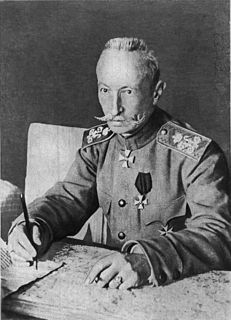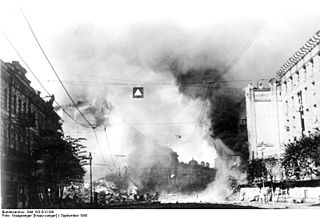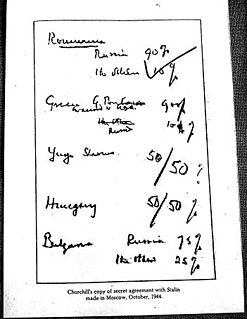
Operation Barbarossa, also known as the German invasion of the Soviet Union, was the code name for the invasion of the Soviet Union by Nazi Germany and some of its Axis allies, which started on Sunday, 22 June 1941, during World War II. The operation was named after Frederick Barbarossa, a 12th-century Holy Roman emperor and German king. The operation put into action Nazi Germany's ideological goal of conquering the western Soviet Union to repopulate it with Germans. The German Generalplan Ost aimed to use some of the conquered people as slave labour for the Axis war effort while acquiring the oil reserves of the Caucasus as well as the agricultural resources of various Soviet territories. Their ultimate goal included the eventual extermination, enslavement, Germanization and mass deportation to Siberia of the Slavic peoples, and to create more Lebensraum for Germany.
Military strategy is a set of ideas implemented by military organizations to pursue desired strategic goals. Derived from the Greek word strategos, the term strategy, when it appeared in use during the 18th century, was seen in its narrow sense as the "art of the general", or "'the art of arrangement" of troops. Military strategy deals with the planning and conduct of campaigns, the movement and disposition of forces, and the deception of the enemy.
Co-belligerence is the waging of a war in cooperation against a common enemy with or without a formal treaty of military alliance. Generally, the term is used for cases where no alliance exists. Likewise, allies may not become co-belligerents in a war if a casus foederis invoking the alliance has not arisen. Co-belligerents are defined in the Encyclopaedic Dictionary of International Law as "states engaged in a conflict with a common enemy, whether in alliance with each other or not".

The Brusilov offensive, also known as the "June advance", of June to September 1916 was the Russian Empire's greatest feat of arms during World War I, and among the most lethal offensives in world history. The historian Graydon Tunstall called the Brusilov offensive the worst crisis of World War I for Austria-Hungary and the Triple Entente's greatest victory, but it came at a tremendous loss of life. The heavy casualties eliminated the offensive power of the Imperial Russian Army and contributed to Russia's collapse the next year.

The Eastern Front of World War II was a theatre of conflict between the European Axis powers against the Soviet Union (USSR), Poland and other Allies, which encompassed Central Europe, Eastern Europe, Northeast Europe (Baltics), and Southeast Europe (Balkans) from 22 June 1941 to 9 May 1945. It was known as the Great Patriotic War in the Soviet Union and some of its successor states, while everywhere else it was called the Eastern Front.

Konstantin Konstantinovich (Xaverevich) Rokossovsky was a Soviet and Polish officer who became Marshal of the Soviet Union, Marshal of Poland, and served as Poland's Defence Minister from 1949 until his removal in 1956 during the Polish October. He was among the most prominent Red Army commanders of World War II.

The First Battle of Kiev was the German name for the operation that resulted in a huge encirclement of Soviet troops in the vicinity of Kiev (Kyiv) during World War II. This encirclement is considered the largest encirclement in the history of warfare. The operation ran from 7 August to 26 September 1941 as part of Operation Barbarossa, the Axis invasion of the Soviet Union. In Soviet military history, it is referred to as the Kiev Strategic Defensive Operation, with the somewhat different dates of 7 July – 26 September 1941.

The first Battle of Smolensk was a battle during the second phase of Operation Barbarossa, the Axis invasion of the Soviet Union, in World War II. It was fought around the city of Smolensk between 10 July and 10 September 1941, about 400 km (250 mi) west of Moscow. The Ostheer had advanced 500 km (310 mi) into the USSR in the 18 days after the invasion on 22 June 1941.

The Pinsk Marshes, also known as the Pripet Marshes, the Polesie Marshes, and the Rokitno Marshes, are a vast natural region of wetlands along the forested basin of the Pripyat River and its tributaries from Brest to the west to Mogilev to the northeast and Kyiv to the southeast. It is one of the largest wetland areas of Europe. The city of Pinsk is one of the most important in the area.

Case Blue was the German Armed Forces' name for its plan for the 1942 strategic summer offensive in southern Russia between 28 June and 24 November 1942, during World War II. The objective was to capture the oil fields of Baku, Azerbaijan SSR and deny their use to the Soviet Union, thereby bringing about the complete collapse of the Soviet war effort.

Operation Saturn, revised as Operation Little Saturn, was a Red Army operation on the Eastern Front of World War II that led to battles in the North Caucasus and Donets Basin regions of the Soviet Union from December 1942 to February 1943.
The 4th Panzer Army was a German panzer formation during World War II. As a key armoured component of the Wehrmacht, the army took part in the crucial battles of the German-Soviet war of 1941–45, including Operation Barbarossa, the Battle of Moscow, the Battle of Stalingrad, the Battle of Kursk, and the 1943 Battle of Kiev.
Stalin's Missed Chance is a study by Russian military historian Mikhail Ivanovich Meltyukhov, author of several books and articles on Soviet military history.

The Kingdom of Romania was neutral for the first two years of World War I, entering on the side of the Allied powers from 27 August 1916 until Central Power occupation led to the Treaty of Bucharest in May 1918, before reentering the war on 10 November 1918. It had the most significant oil fields in Europe, and Germany eagerly bought its petroleum, as well as food exports.

The Arkhangelsk–Astrakhan line, or A–A line for short, was the military goal of Operation Barbarossa. It is also known as the Volga–Arkhangelsk line, as well as the Volga–Arkhangelsk–Astrakhan line. It was first mentioned on 18 December 1940 in Führer Directive 21 which enunciated the set goals and conditions of the German invasion of the Soviet Union, describing the attainment of the "general line Volga–Archangelsk" as its overall military objective.

Friedrich Karl ("Fritz") von Loßberg was a German colonel and later general, of the First World War. He was an operational planner, especially of defence, who served as Chief of Staff in the 2nd, 3rd and 4th armies. He was present at the Battle of the Somme, the Battle of Arras and the Third Battle of Ypres.

The Percentages Agreement was a secret informal agreement between British prime minister Winston Churchill and Soviet leader Joseph Stalin during the Fourth Moscow Conference in October 1944. It gave the percentage division of control over Eastern European countries, dividing them into spheres of influence. Franklin Roosevelt was consulted tentatively and conceded to the agreement. The content of the agreement was first made public by Churchill in 1953 in the final volume of his memoir. The US ambassador Averell Harriman, who was supposed to represent Roosevelt in these meetings, was excluded from this discussion.

The first Jassy–Kishinev offensive, named after the two major cities Iași (Jassy) and Chișinău (Kishinev) in the area, was a series of military engagements between 8 April and 6 June 1944 by the Soviets and Axis powers of World War II. Richard C. Hall also refers to a first Jassy–Kishinev operation which began on 5 April, without providing an exact date for its end. According to Glantz, the purported offensive was a coordinated invasion of Romania conducted by Red Army's 2nd and 3rd Ukrainian Fronts, in accordance with Joseph Stalin's strategy of projecting Soviet military power and political influence into the Balkans.

ŁachwaGhetto was a Nazi ghetto in Western Belarus during World War II. Located in Lakhva, Belarus), the ghetto was created with the aim of persecution and exploitation of the local Jews. The ghetto existed until September 1942. It was the location of one of the first Jewish ghetto uprisings.

Kantokuen was an operational plan created by the General Staff of the Imperial Japanese Army for an invasion and occupation of the Russian Far East, capitalizing on the outbreak of the Soviet-German War in June 1941. Involving seven Japanese armies and a major portion of the empire's naval and air forces, it would have been the largest combined arms operation in Japanese history up to that point, and one of the largest of all time.